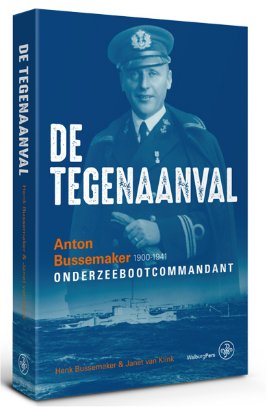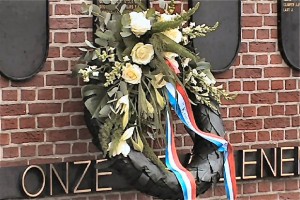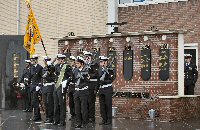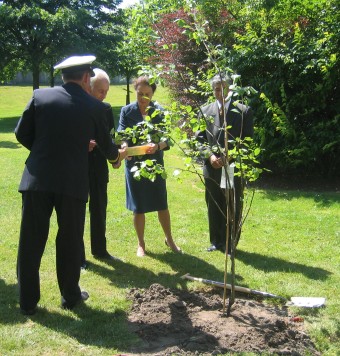Press release
Sunken submarine K XVI found
In the South China Sea, the Dutch submarine HM K XVI was sunk during the Second World War. Now it has been found. An Australian-Singaporean sport diving team found the long-sought submarine in early October after a tip from a local fisherman in the waters north of the island of Borneo.
Experts from the Royal Netherlands Navy have studied photo images made by the diving team. There are clear features that can only be found on Dutch submarines. From this information, together with the location of the submarine in relation to other sunken Dutch submarines, it has been determined that it is the K XVI. This puts an end to a long period of uncertainty for the relatives of the crew. The relatives were informed by the Commander of the Naval Forces, Vice Admiral Matthieu Borsboom.
HM. K XVI, a thousand-ton submarine and a crew of 36 people including six Indonesian crewmembers, was part of the allied force that was to prevent the Japanese invasion of the then Dutch East Indies. After the sinking of the Japanese submarine Sagiri on the night of December 24 to December 25, 1941, the K XVI perished the next morning after a torpedo attack by the Japanese submarine I-66.
In the Second World War, seven submarines of the Royal Navy were lost in hostilities, six of them during war patrols. A seventh submarine was bombed in the port of Surabaya. Six submarines had been missing for a long time. Since 1982, four boats have been localized and identified, mainly thanks to the efforts of close relatives of the crews and the Stichting Nabestaanden Onderzeeboten 1940-1945. Now HM K XVI has been found. Only HM O 13, which perished on the North Sea, has not been localized yet, causing great grief of the relatives of the crew, despite various efforts.
Katja Boonstra-Blom is the daughter of one of the crewmembers of HM K XVI and member of the board of the Stichting Nabestaanden Onderzeeboten 1940-1945: “We are very happy and grateful for all the support of everyone who contributed to finding the K XVI. We have never forgotten the crew members in all those years in which they were missing. “
The wreck of the K XVI is considered a wargrave. For this reason, the exact position of the submarine is not disclosed. Divers are requested to leave the wreck untouched out of respect for the killed crew and their relatives.
In consultation with the relatives and supported by the Royal Netherlands Navy, we will examine how HM K XVI and her crew’s will be paid their last honors.
 De Nederlandse onderzeeboot Hr.Ms. O 16 behaalde in de nacht van 11 op 12 december 1941 het eerste belangrijke succes van de geallieerden na de Japanse aanval op Pearl Harbor. De onderzeeboot torpedeerde op uiterst spectaculaire wijze vier Japanse troepentransportschepen. Commandant Anton Bussemaker (1900-1941) kreeg de Militaire Willems-Orde. Postuum. De O 16 liep op 15 december 1941 op een mijn. Van de bemanning overleefde één man het drama op zee.
Al kort na de Tweede Wereldoorlog inspireerde de O 16 romanschrijvers. De werkelijkheid is echter totaal anders. Nabestaanden Henk Bussemaker en Janet van Klink beschrijven in De Tegenaanval 75 jaar na het begin van de oorlog in Nederlands-Indië aan de hand van officieel archiefmateriaal en persoonlijke brieven het échte levensverhaal van de commandant van de legendarische O 16. Een leven in aanloop naar een oorlog.
Lees verder …
De Nederlandse onderzeeboot Hr.Ms. O 16 behaalde in de nacht van 11 op 12 december 1941 het eerste belangrijke succes van de geallieerden na de Japanse aanval op Pearl Harbor. De onderzeeboot torpedeerde op uiterst spectaculaire wijze vier Japanse troepentransportschepen. Commandant Anton Bussemaker (1900-1941) kreeg de Militaire Willems-Orde. Postuum. De O 16 liep op 15 december 1941 op een mijn. Van de bemanning overleefde één man het drama op zee.
Al kort na de Tweede Wereldoorlog inspireerde de O 16 romanschrijvers. De werkelijkheid is echter totaal anders. Nabestaanden Henk Bussemaker en Janet van Klink beschrijven in De Tegenaanval 75 jaar na het begin van de oorlog in Nederlands-Indië aan de hand van officieel archiefmateriaal en persoonlijke brieven het échte levensverhaal van de commandant van de legendarische O 16. Een leven in aanloop naar een oorlog.
Lees verder …

 On Wednesday a commemoration service was held in Den Helder for the relatives of the crew of the submarine HM K XVI (K 16).
On Wednesday a commemoration service was held in Den Helder for the relatives of the crew of the submarine HM K XVI (K 16). The submarine service monument was unveiled yesterday in Den Helder. The Commander of Naval Forces, Vice Admiral Matthieu Borsboom, spoke during the ceremony about the companionship of submarine personnel, depicted in the memorial.
The submarine service monument was unveiled yesterday in Den Helder. The Commander of Naval Forces, Vice Admiral Matthieu Borsboom, spoke during the ceremony about the companionship of submarine personnel, depicted in the memorial.
